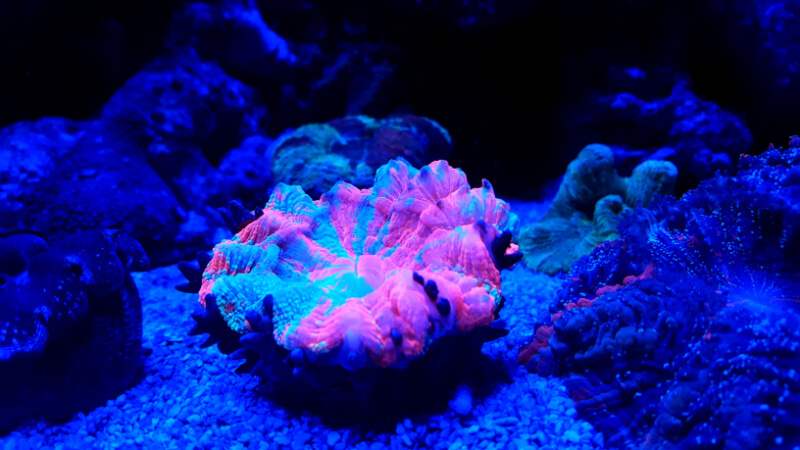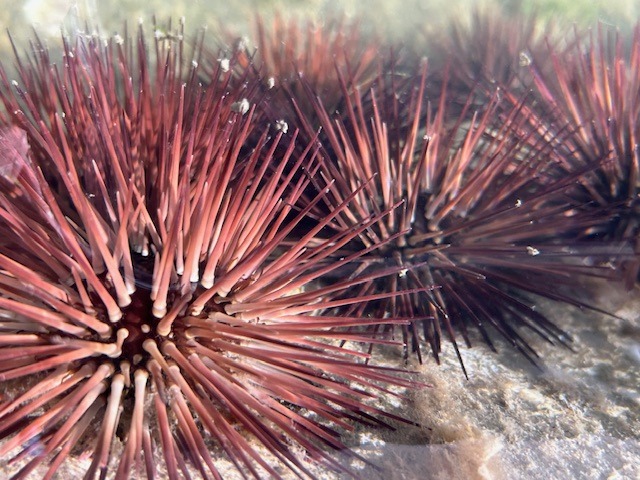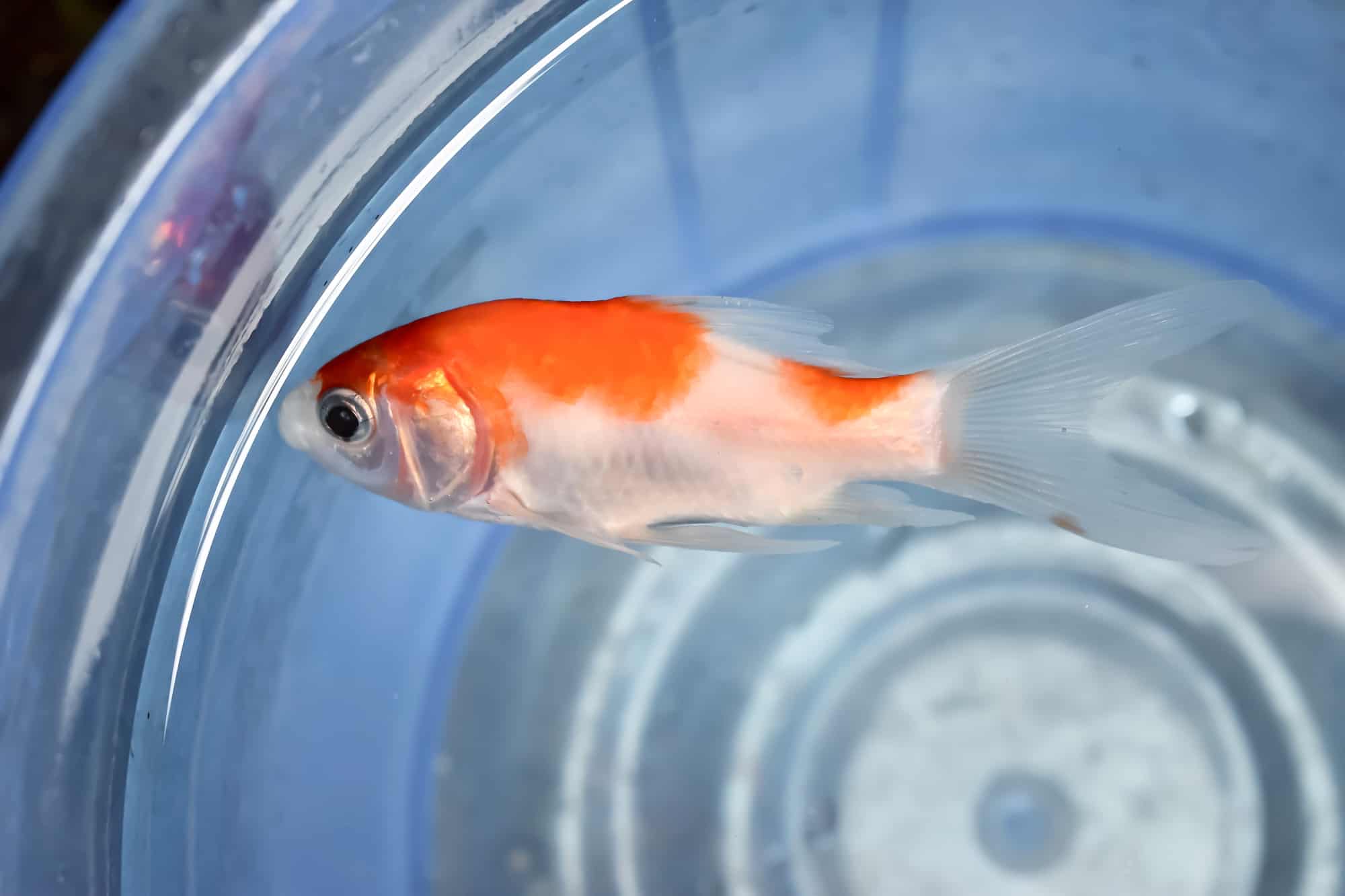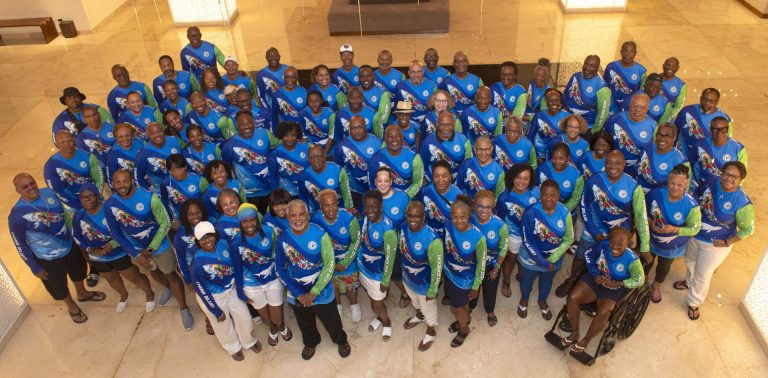Quick Facts 
Other Names: Doughnut Coral, Disk Coral, Australian Scoly Coral, War Paint, Pinwheel Button, and Bleeding Apple
Tank: 10 gallons
Water: 73F to 84F, 8.1 to 8.4 pH, 8 to 12 dKH, 1.025 SG.
Lighting: 100-150 par
Water Flow: 20 to 40 times turnover
Size: 3-4 in in diameter
Feeding: 2-3 times a week foods like mysis shrimp, brine shrimp and gulf shrimp
Mates: LPS and SPS corals like Brain Corals
Predators: Green Hydnophora, Galaxea Coral and Starry Cup Coral
Fragging: Not recommended
Scolymia or Scoly Corals are a captivating addition to any marine tank. With their easy-going nature and ability to thrive in diverse conditions, these corals make them an excellent choice for both beginners and experienced hobbyists.
This care guide will walk you through essential tips to ensure your Scoly Coral flourishes, from proper placement and lighting to feeding techniques that showcase their unique beauty. Let’s being!
Species Summary
The Scoly Coral is a Large Polyp Stony, also known as an LPS coral. Its common names are Doughnut Coral, Disk Coral, Australian Scoly Coral, War Paint, Pinwheel Button, and Bleeding Apple. Scolymia is the genus, and you can find species such as Scolymia australis and Scolymia vitiensis which is part of the Mussidae family.
The coral can be found throughout the Pacific, such as in Australia, with a rare species found in Indonesia. Nowadays, most hobbyists find the coral on reef slopes of the Great Barrier Reef.
Appearance
Scoly is a popular coral because of its vibrant color schemes, from green and red to orange and blue. The coral does not feature the usual colony of branches, and its round body resembles a single button with a mouth in the center.
These corals have sweeper tentacles that extend when feeding or at nighttime. Overall, the Scoly is a great choice for adding a unique species to your aquarium.
Scoly Coral Care
The Scoly is a hardy coral that usually takes well in new surroundings. To thrive in your tank you need to make sure it has enough space and the water is kept within the recommended parameters to avoid parasites or a chemical imbalance.
Tank Size
The Scolymia coral does well in nano aquariums, so you will do well with the recommended 10-gallon tank size. Ensure your coral has enough room to fully grow since it likes to extend its tentacles and inflate itself to about two times their size.
Water Parameters
Even with its ability to adapt to its surroundings, your coral still needs the right environment to be as close as possible to natural sea water.
Water temperature: 73-84 degrees Fahrenheit
pH levels: 8.1-8.4
Water hardness: 8-12 dkh
Specific gravity: 1.025
Calcium: 400 ppm
Magnesium: 1350 ppm
Phosphate: 0.05-0.1 ppm
Ammonia: 0 ppm
Nitrate: 0 ppm
Nitrite: 0 ppm
Tank Setup
Scoly Corals enjoy a fine sandbed in their space, which is okay to add as long as your coral does not get coated in sand. Otherwise, it may become difficult to feed your coral. If you are worried about your coral sinking into the sand or falling over, you can always provide a rock or another flat surface.
Placement
Place your coral in a low-medium spot with less lighting. It is also essential to provide several inches of space for your coral to grow, inflate, and extend its tentacles, especially if you are placing other LPS corals in the tank. Failure to provide ample space can result in your coral disturbing its neighbors or vice versa.
Lighting
While Scolymia Corals are photosynthetic, they are not overly demanding when it comes to their lighting. Moderate lighting with a range of 100-150 par is enough to keep your coral healthy and comfortable. You can use T5, LED, or Metal Halides bulbs in your coral’s tank, and a 14-20K color spectrum makes it easier to enjoy your coral’s coloration.
Filtration / Water Flow
A low-moderate water flow of 20 to 40 times turnover is a good range because it can channel food toward your Scoly Coral while sweeping away debris and waste. It is best to place your coral at a slight angle to ensure the unwanted particles are fully removed by the flow.
Author Note: If you are worried about the flow harming your coral or falling over, just make sure it is on a flat surface and on lower rock.

Acclimation
Scolymia Corals can adapt to any mature tank as long as you don’t surprise it with sudden changes. For example, your coral may have become used to less lighting while in its container during transit.
Author Note: It is best to introduce your coral to its tank under low lighting to prevent shock and stress. Once your coral is used to its new surroundings, you can move your coral to its designated spot and adjust the lighting to the recommended range.
Growth / Size
While Scolymia Corals tend to grow slower than other LPS corals, a healthy diet and proper water conditions can help your scoly coral reach 3 to 4 inches in diameter.
Is My Scoly Coral Dying?
The Scoly is a hardy coral that adapts well, but that does not make your coral invincible. If you notice an exposed skeleton, which is a portion of white on its body, your Scolymia Coral may be sick or dying. Two possible causes are as follows:
- Your coral is being eaten or catching a virus.
- Overharvesting since cutting too much of the good stuff will stress and damage your coral.
Fortunately, the sign of a sick or even dying coral does not have to be a death sentence. If the damage is not too severe or in the coral’s mouth, you may be able to save it by following the four steps below.
- Have two containers ready. Both of them have aquarium water and one of them will be used to rinse off the coral.
- Add 10 drops of iodine solution per 1/4 gallon of aquarium water to one of the containers.
- Use protective gear to handle your coral and carefully remove any bubble algae (see this Bubble Algae Removal Care Guide for more information).
- Additional trimming is not recommended unless you see sharp septa since these can pierce or cut thin tissue of the coral.
- Dip your coral in the iodine solution for about 10 minutes.
- Remove your coral from the iodine container and rinse it off in the other container.
- Place your coral back in your aquarium or in quarantine if you have another tank. Make sure the water flow is low to medium to prevent further injury.
- Start feeding your coral and be patient since you might not see any eating until a day or two.
Author Note: In addition to an exposed skeleton, a loss of appetite could mean your coral is stressed, injured, or dying. The first thing to check would be the water conditions since inaccurate parameters could lead to the aforementioned issues.
Feeding
Target feeding your coral two to three times a week is a great way to ensure it grows and thrives. Scoly Corals enjoy eating mysis shrimp, brine shrimp and gulf shrimp. They can also be fed seafood and other special coral food thanks to their larger than usual mouths.
Scolymia Corals are able to produce their own energy from the photosynthesis of the zooxanthellate algae with which it has a close relationship. The key is to supplement this with target feeding to ensure your coral gets the nutrients and energy it needs.
There are special tools designed for target-feeding corals, and all you need to do is squirt the pasty food near its mouth. Your corals can enjoy a delicious meal with plenty of nutrients, and you can watch as your coral uses its tentacles to catch and eat the food.
Compatibility
This coral is semi-aggressive and may use its sweeper tentacles to damage its neighbors. To create a peaceful environment make sure to give your coral enough space and only place compatible species in the same tank. There are several types of LPS and SPS corals in addition to other species that do well with these corals. Here we share a few of them.
- Plate Corals
- Brain Corals
- Mushroom Corals
- Tridacna Clams
- Zoanthids
There are also certain corals that are not compatible with your Scolymia Coral so stay away from the ones below.
- Green Hydnophora
- Galaxea Coral
- Starry Cup Coral
If you want to place your Scoly Coral in the same tank as reef-safe species, be sure to choose species that do not nibble on these corals like the Picasso Triggerfish.
Propagation and Fragging
Unlike other corals, it is not a good idea to frag your Scoly Coral. This is because you would need to cut through its living flesh which could lead to injury or infection. Remember, this coral does not have branches to easily remove and due to its single circular shape, it will not return to its round shape for a while. All of this is assuming it survived the fragging process.
Author Note: The corals that do survive are at risk of not recovering their original shape, so they may not be able to eat properly. It is also worth noting that Scolymia Corals are expensive, and the risk of losing a colony might not be worth the small chance of successful fragging.
Rare Scoly Coral
There is an Australian Scoly Coral known as Homophyllia australis that is quite rare due to having orange among its colors. This is because orange scolies are not common and fragging has many challenges so duplicating this coral is very difficult.
A good looking scolie could cost a few hundred dollars and if it has some orange it could be a couple thousand, but the record was set by an Australian Scolie in Japan for over $5,000! We believe this is a good enough reason to master your coral caring skills.
Wrapping Up
To sum it up, taking care of Scoly Corals lets you enjoy a beautiful underwater show in your own aquarium. By feeding it 2-3 times a week, placing it in a low to medium spot and following the other tips covered in this guide, you will be able to create a home where these special corals grow and show off their stunning colors.
Have fun with it! As you care for your Scoly Coral, you’ll see it become even more amazing. In case you were curious we have other Coral Care Guides and also a Facebook page in case you want to tag us when sharing cool photos of your coral.
If you have any questions don’t hesitate to reach out to us and we wish you best of luck!



